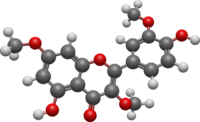 | |
 | |
| Names | |
|---|---|
| IUPAC name 4′,5-Dihydroxy-3,3′,7-trimethoxyflavone | |
| Systematic IUPAC name 5-Hydroxy-2-(4-hydroxy-3-methoxyphenyl)-3,7-dimethoxy-4H-1-benzopyran-4-one | |
| Other names Quercetin 3,7,3'-trimethyl ether | |
| Identifiers | |
3D model (JSmol) | |
| ChEBI | |
| ChemSpider | |
| MeSH | C008751 |
PubChem CID | |
| UNII | |
CompTox Dashboard (EPA) | |
| |
| |
| Properties | |
| C18H16O7 | |
| Molar mass | 344.319 g·mol−1 |
Except where otherwise noted, data are given for materials in their standard state (at 25 °C [77 °F], 100 kPa). | |
Pachypodol is a chemical compound classified as an O-methylated flavonol. It can be isolated from a variety of plants including Calycopteris floribunda , [1] Pogostemon cablin , [2] and Croton ciliatoglanduliferus . [3]